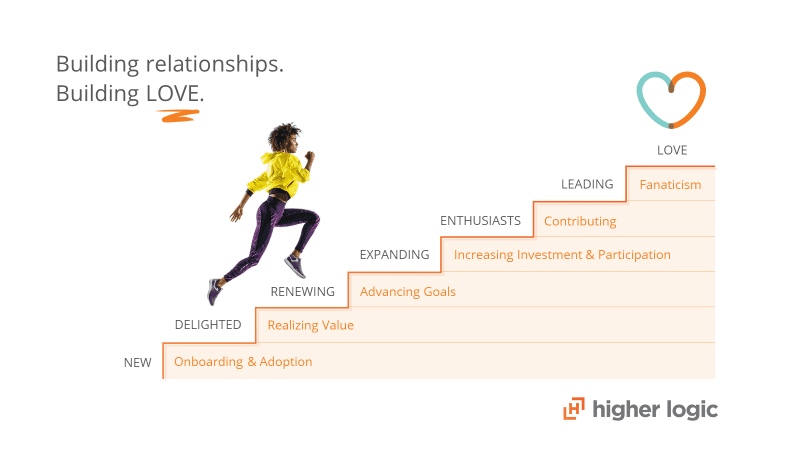
How to Craft Your Winning Member Engagement Strategy
By consistently keeping members engaged, you won’t just attract and keep more members, you can push through legislative wins, find more volunteers for your programs, and increase event attendance and other revenue streams.
If your organization were a car, membership engagement would be the gasoline. For organizations like associations, societies, and institutes, member engagement fuels core objectives.
But does member engagement just happen? Not usually.
Member engagement requires ongoing, proactive processes to reach members with the relevant connections, content, and benefits for them, at the right times and in the right ways.
By consistently keeping members engaged, you won’t just attract and keep more members, you’ll have the strength in numbers to push through legislative wins, more volunteers for your programs, and an increase in event attendance and other revenue streams.
But it’s not just the benefits that prove you should focus on member engagement – a lack of engagement has consequences. According to the 2021 Membership Marketing Benchmarking Report, the number one reason why association members lapse is “lack of engagement with the organization.”
Clearly, member engagement is critical.
So how can you actually implement a member engagement strategy that works? Especially when everyone isn’t starting at the same level of involvement, and personalized outreach with the perfect content or opportunity for each member is time-consuming.
Let’s look at the basic building blocks of any robust member engagement strategy:
- The Framework: The Member Engagement Ladder
- The Characteristics: Marks of a Great Strategy
- The Plan: Practical Elements of Your Member Engagement Strategy
The Framework: Understanding the Member Engagement Ladder
Meet the Member Engagement Ladder. It demonstrates the ideal member journey. A new member starts out interested but not very involved, and as they renew year after year, they grow into highly involved leaders and fans.
Granted, not every member will follow this path, and not every member will ultimately stick around. But if you can set up a solid strategy for encouraging these behaviors, you can achieve your goal of getting members more involved and invested by deepening your relationships with them one step at a time.
Keep in mind that it’s a process. It’s not about moving them to the top of the staircase from the bottom step in one giant leap.
But it is about talking to your members as if you know who they are, with the right message, to the right person, at the right time, so that you can move them up from one step to the next, repeatedly, until you get them to the top. We like to call this journey “Higher Love.”

Want to learn more about the Member Engagement Ladder? Check out our Guide: The Psychology Behind Getting Members More Involved.
Now, if you want to implement a great member engagement strategy that meets members where they are (and helps encourage them up the ladder), your strategy needs to have these five characteristics.
The Characteristics: 5 Marks of a Great Member Engagement Strategy
1. Member-Centric
You can provide high-quality content all day long, but it won’t help you much unless members feel that it’s highly relevant and timely. That can be challenging, considering your members are at different career stages and have varied needs. Fortunately, you can take steps to create more member-centric experiences that will resonate with your members.
You have to start with your member data. If you have a website and/or send out emails, that’s a great start. What are members clicking on? What pages do they spend the most time on and revisit? Your members are generating valuable behavioral data just waiting for you to apply to your engagement strategy. If you have a marketing automation platform, you have a way to harness that data through website tracking and robust email metrics. If you have an online community platform, you have another source of invaluable data at your fingertips as you use the community to engage.
Want to learn more? Don’t miss our series with Wicket and CSAE: Let’s Talk About Member Data, available on-demand.
2. Year-Round
Your member engagement strategy should be in action all year. Often, the classic approach is to connect with members a couple times during the year, usually when you want them to buy something, then send a renewal notice when the year’s up. But that approach positions your organization as a bill collector rather than showing members how valuable their membership is year-round.
Consider this from members’ point of view. If they’re not involved throughout the year, they may get your renewal letter and start wondering, “Why should I keep spending this money? Am I getting my money’s worth?” That sentiment applies to onboarding and first-year engagement well. The getting-to-know-you phase is a critical one that will help determine whether members choose to stay with your organization. With that in mind, here’s one key component of fostering meaningful connections with new members:
- Create a new member welcome campaign. You need to make a great first impression when they sign up. This means introducing them to your organization in a digestible, thoughtful way and getting them engaged in all you have to offer. Welcome them with open arms through your automated welcome email campaign that breaks up key information into bite-sized pieces.
3. Hybrid
When you think about sparking meaningful connections with members, it helps to consider the social dynamics that resonate in your own life. How do you interact with friends and family — do you only meet with them one-on-one, or only meet with them in groups? Chances are, you’ve mostly done both! This reflects what your members want too. Instead of one single way of interacting, you’ll want to take a hybrid approach.
To add depth to the engagement experience, give your members multiple ways to stay engaged, like connecting in your online member community, attending a casual virtual event with a few other members around a topic of interest, and/or a personal phone call. Members need to feel personal attention from you (read: not just a generic greeting or outreach, and more than just their first name in the email). They also need the energizing connectedness of member groups, and the wealth of information and support that can bring, in the form of online communities and virtual events.
See how the Educational Theatre Association uses their online member community to connect members who feel alone.
4. Automated
Engaging your members can feel like a lot of time-consuming, manual work, especially if your tech stack isn’t updated or integrated. A great member engagement strategy will take work, but it should be work on the right projects – strategy improvements, building creative content, and testing what’s working and what’s not.
Instead, many association teams find themselves wasting hours fighting data and pulling manual lists, sending out one-off renewal notices, calling members to ask why they didn’t renew, and so on.
What if there was a better way? Many organizations are achieving envy-worthy levels of personalization through automation and integrations. These approaches make it easier for you to focus on the most important things about your member engagement strategy instead of busywork.
Here are two examples of automation in action:
Run a re-engagement email campaign.
Let’s say your association wanted to use marketing automation software to re-engage members who haven’t participated in a while. With engagement scoring tools built into Higher Logic Thrive Marketing, your association has a way to identify disengaged members throughout the year and communicate with them in a focused, strategic way that continually conveys your association’s value. After determining which members aren’t engaged, you can separate and segment the disengaged members in your audience, so you can send them personalized messages.
See how Professionals Australia ran an automated email campaign to engage existing members.
Engage at scale in your online member community.
When it comes to connecting your members online, you can use tools like automation rules, built into Higher Logic Thrive Community, to engage them at scale – with less manual labor.
For example, if you allow nonmembers to access your online community, you could use an automation rule to send them an invitation to join. The National Association of School Nurses tried this automation rule. They targeted the rule to online community users who had never joined the association but had logged into the website and completed at least 10% of their profile. For this campaign, NASN reached 4,051 people. Of those recipients, 400 became members, achieving a 10% conversion rate. Pretty good results for one automated email!
5. Embraces New Rules
As the needs of your membership change over time, you’ll want to adapt your strategy and reevaluate efforts to improve engagement. Although a business-as-usual approach may feel comfortable, it can limit your organization’s ability to thrive.
By rethinking some of your engagement tactics, you open the door to new ideas that can help your organization grow and showcase its value – particularly as younger generations join the fold.
That doesn’t mean you need to jettison everything that lacks a 21st-century digital component (there can be enormous value in kickin’ it old school and picking up the phone to call individual members – in fact, many associations build notification steps into their email campaigns to do just that).
Even small changes can make a big difference and allow your organization to stay relevant. Empathy plays a significant role here, so think about engagement from your members’ perspectives. What’s convenient for them and blends seamlessly with the way they use technology and how they operate day-to-day? What might energize their desire for connection?
Need some ideas? Check out this list of seven processes you could modernize to increase member engagement.
Now, let’s get practical. What are the key inputs to include in your strategy?
The Plan: 10 Practical Elements for an Effective Member Engagement Strategy
Use this framework to build out, validate, and measure your organization’s member engagement strategy.
1. Goals
In order to know if your strategy is working, you need to begin with clearly developed and easily measurable goals. Most important? Make sure your goals are aligned with the goals of your organization. (Member engagement, at its core, will benefit all aspects of your association – retention, event registrations, member satisfaction – but it’s up to you to clearly define those connections).
- Ask yourself: How would you like your relationship with your members to change through this plan? How will you know if you’ve achieved your goal?
- Try this: Pin down that cloud by making your goals concrete with numbers and by outlining specific actions you will take to get there. “Engagement” can feel nebulous, but it’s really about what it means to you and your members.
2. Personas
Creating well-developed personas for your target members and their behaviors helps you to know what your members need and what you’re in competing against for their attention.
- Ask yourself: Who are you targeting? What are the composite characteristics and behaviors for each group?
- Try this: Delve into your data to refine your personas. If you have engagement tools like an online community or marketing automation software, your members are generating valuable behavioral data you can use to create your personas.
- Read this: Why You Should Be Segmenting Your Members By Data Rather Than By Type
3. Problems
If your association can’t help to solve your members’ most important problems, then they won’t have a reason to engage or maintain their membership status.
- Ask yourself: What are each persona’s most urgent and pervasive challenges? How can your organization help to solve them?
- Try this: If you want to understand your members’ pain points, start with research. Use engagement tools like online community and marketing automation to gather the behavioral data that reveals their problems, what they value, and how you can help them.
4. Value
The value your organization offers is how you will help to solve the problems and challenges your members face. Whether through quality content, connections with experts, webinar series, or networking opportunities, your association’s value proposition will give your members a reason to stay engaged.
- Ask yourself: What can I offer to solve my members’ problems? What information, collaboration, or networking opportunities do they need?
- Try this: From the research you did in steps two and three, you should have a good handle on what your members need. Match their needs with the benefits you can offer.
- Read this: 8 Irresistible Member Benefits That Convince People to Join and Renew
5. Delivery & Tactics
Next, you need to decide what format you will use to deliver your value to your members. You have several options: online, at an event, in a publication, through other various tools, or all of the above.
- Ask yourself: Which methods of delivery would be most convenient for your members? Fewer barriers to consuming the value you provide means more people will receive that value and come back for seconds and thirds.
- Try this: If any or all of your benefits live online, make sure the platforms are integrated. This way, you can create a single sign-on (SSO) for your members so that they can easily log into your website and all the associated benefits, like your learning management system, your online community, or your mentoring program.
- Read this: Integrate for Success: 3 Sweet Results of AMS Integrations
6. Measurement
Since there are different degrees of engagement, you need different metrics to track your success and identify your weaknesses. Then, you can make adjustments to specific aspects of your engagement plan without having to waste your time on areas that are working well.
For instance, let’s say you’re hosting a webinar series. Rather than measuring how many members attended versus how many members didn’t attend, look at smaller steps as well – like clicks on your email, requests for the recording, questions asked during the webinar, etc. Measuring these points will give you a bigger and clearer picture to work with as you tweak and refine your system.
- Ask yourself: What metrics should I use to track my member engagement strategy? How do my metrics relate to the goals I’ve set for my strategy?
- Try this: You’ve set up overall goals for your member engagement strategy, but set little goals that you can track and measure for the smaller projects within your strategy.
- Watch this: Let’s Talk about Member Data
7. Communication Plan & Tools
Next, it’s time to decide how you will engage your members as they climb the engagement ladder. The right software tools are essential for executing your member engagement strategy.
- Ask yourself: How will you engage with your target audience and make them aware of opportunities? Will you use marketing automation, snail mail, online community, word of mouth, search engines, social media, or a combination of tools? How often will you communicate?
- Try this: Nobody wants to be bombarded by irrelevant emails, but nobody wants to miss out on an opportunity or content that’s relevant to them. The best approach? Send the right communication to the right people at the right time using marketing automation software.
8. Consistent Action
A member engagement strategy is an ongoing initiative. A successful engagement strategy includes ongoing opportunities for members to engage. This takes consistent effort on the part of your organization to deliver ongoing value to your members while making adjustments to your plan where needed.
- Ask yourself: How will this strategy result in members staying engaged and continuing to get value from our organization in the long term? How is that going to be maintained and who will be responsible for maintaining it?
- Try this: Schedule time every quarter to review your metrics and your tactics. If you invested in tools, utilize their analytics reports to see how much progress you’ve made toward your goals.
9. Staffing
It’s important to have a clear outline of who among your staff is responsible for each aspect of your member engagement strategy so everyone understands the expectations and their accountability.
- Ask yourself: Who will do the work? Who will monitor progress? Who is ultimately responsible for the goals being met?
- Try this: Since this aspect of your member engagement strategy will likely live across different departments, it will take interdepartmental coordination. Consider setting up an “engagement task force” in your organization, or at least make sure you have a project lead for every department.
10. Buy-In
Your plan is complete. You’ve got goals, metrics, and staff. Now it’s time to take this to your leadership (whether it’s your boss, board, or executive team) and show them why engagement is a priority and why your plan will work. Their buy-in is crucial for your success and will ensure you get the funding and time you need to execute the plan.
- Ask yourself: Did I align our member engagement strategy with our organization’s business objectives and value proposition? Do I have any member stories or quotes that will help drive the point home? What’s the business impact of our member engagement strategy?
- Try this: If you’ve successfully recruited people from other departments to help execute your member engagement strategy, see if they’ll co-present with you. Hearing it from multiple departments is even more convincing than one – and helps drive the point home that it’s an organizational need.
You’re Ready to Strategize for Member Engagement
The past year has brought many changes for associations, but one thing has remained constant: Member engagement is a top priority. In fact, many organizations have increased their focus on engagement since the pandemic began. And now, you’re ready to deliver that winning member engagement strategy.
For more inspiration, check out these resources on member engagement:
- The Psychology Behind Getting Members More Involved
- 5 Key Elements of a Winning Member Engagement Strategy
- 7 Rewarding, Easy-to-Implement Ways to Engage Your Member Base
- Reignite Your Member Engagement Strategy in 2021
Editor’s note: This post was originally published on August 28, 2014 by Joshua Paul. It has since been refreshed to make sure we’re giving you the latest and greatest.



